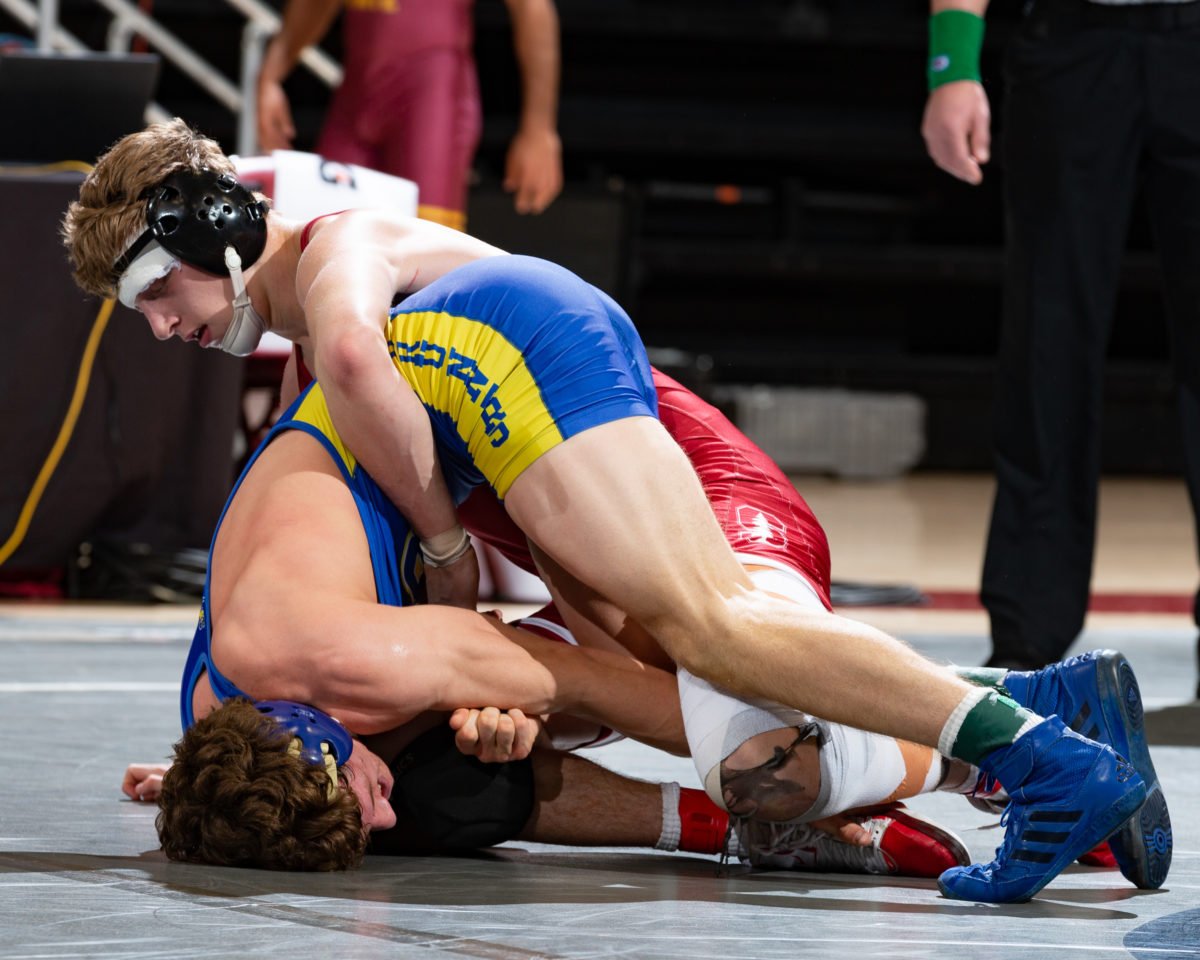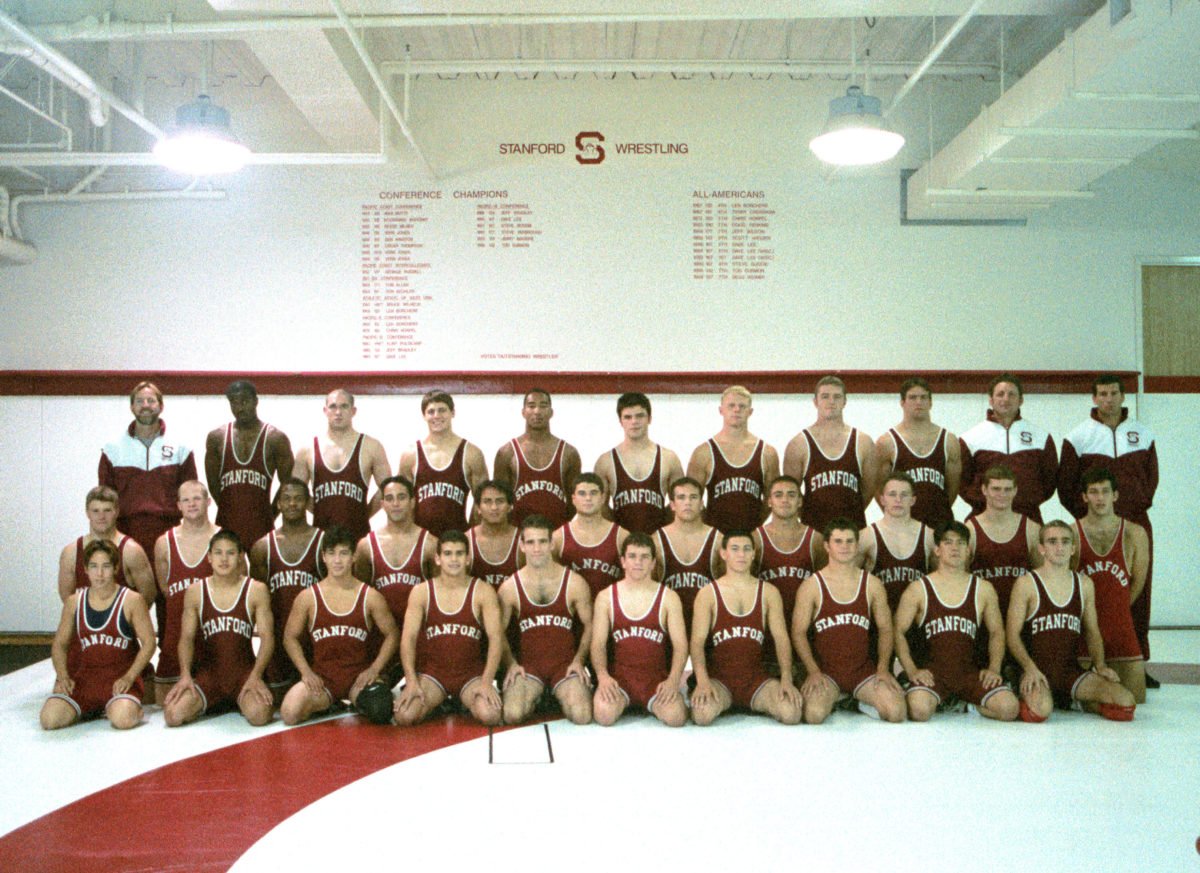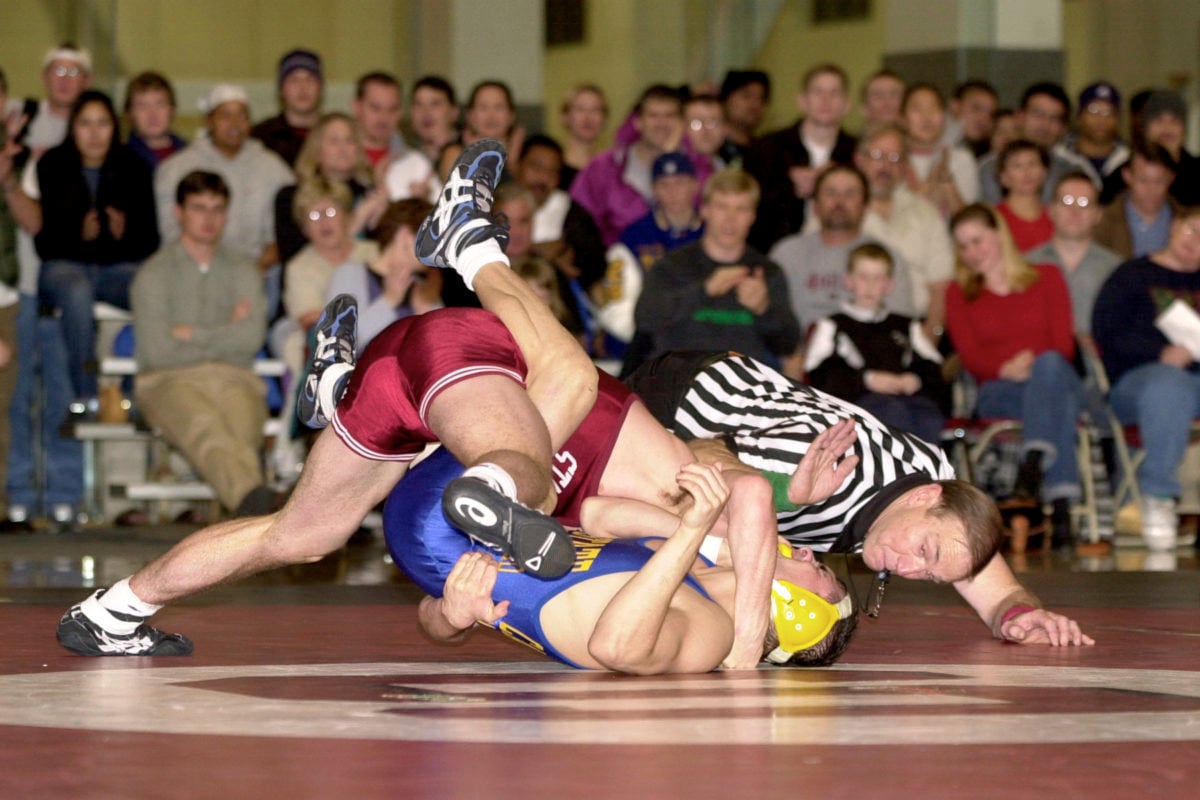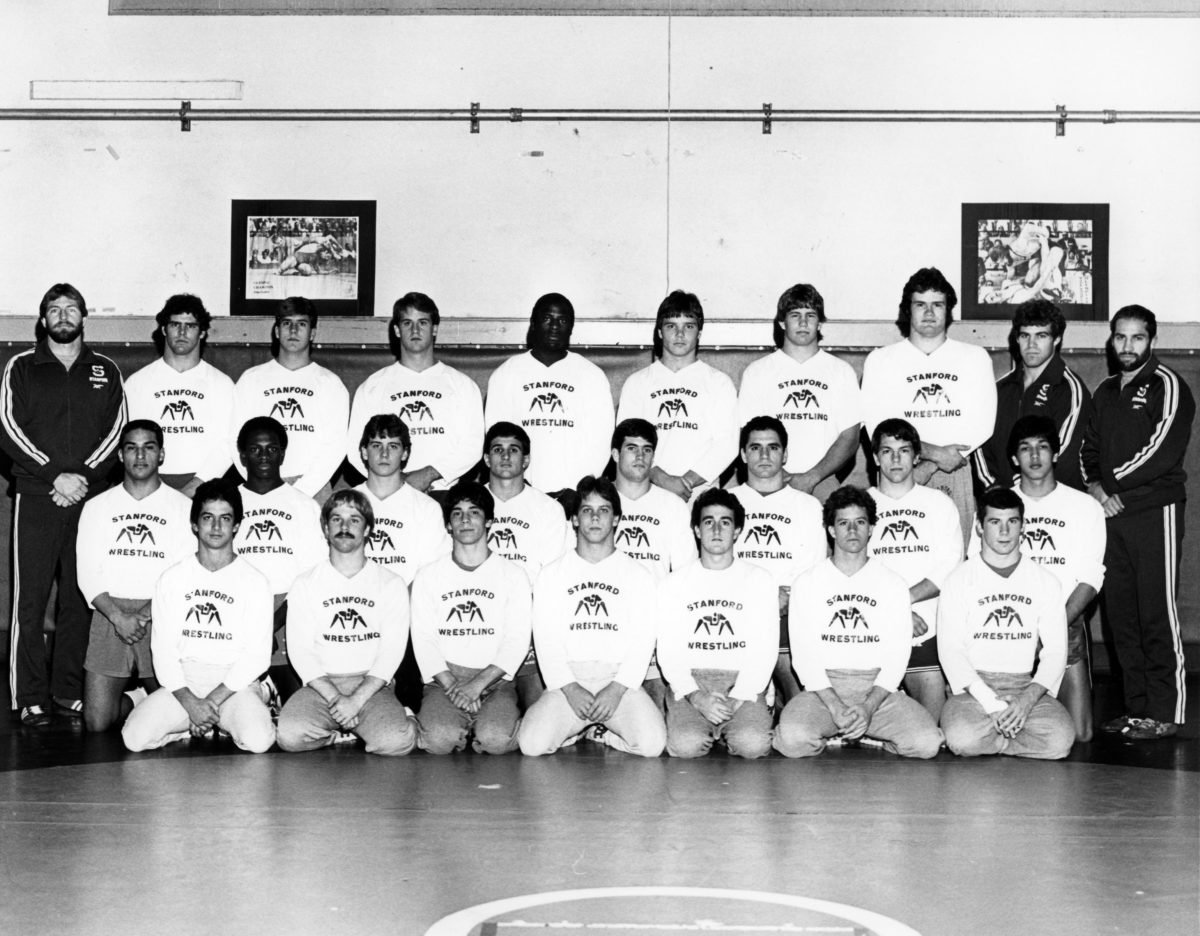“I Am Stanford” is part of a collection of articles documenting the reactions of the Stanford athletic community to the July 8 announcement that Stanford Athletics would discontinue 11 varsity programs, including the wrestling team, following the 2020-21 season.
Stanford wrestling’s last full season was arguably the greatest of the program’s 104-year history on The Farm. In 2019, Stanford won its first Pac-12 championship and head coach Jason Borrelli was named Pac-12 Coach of the Year.
Expectations remained high heading into 2020, but Borrelli’s team again exceeded them. The Cardinal finished with five NCAA tournament qualifiers: then-redshirt junior Nathan Traxler; then-redshirt freshmen Real Woods, Shane Griffith and Tyler Eischens; and then-true freshman Jackson DiSario. Stanford also had three All-Americans (Traxler, Griffith and Woods).
The four freshmen NCAA tournament qualifiers constituted the most of any program in the nation, and the three All-Americans tied for most in program history. However, the season, which seemed on track to break more records, was cut short prior to the NCAA Tournament due to COVID-19.
The duo of Griffith and Woods finished the season with 28-0 and 19-1 records, respectively, in their first year of eligibility. Griffith was named a Hodge Trophy finalist and Pac-12 Wrestler of the Year for his efforts, and both claimed Pac-12 titles for their respective weight classes.
“Our program is doing great, and it’s doing better than it ever has,” said Gabriel Townsell ’20, adding that wrestling at Stanford is on a clear “upward trajectory.”
Following the university’s decision to discontinue the program after the upcoming academic year, though, Borrelli’s team may never get another chance to prove Townsell right.
Although the University has said that the decision to cut the team’s varsity status is “final,” the wrestling community has done everything in its power to keep the program alive.
“The athletic excellence that Stanford talks about so often [is] tied to hundreds of dreams, if not thousands of dreams, every year,” Townsell said. “I hope that we can get that message to the administration such that it’s clear that this is something that’s all-important to a greater number of people than, I think, they can even possibly understand.”
The ‘garbage compactor sport’
The sport of wrestling was first introduced at the (ancient) Olympic level in 708 BC in Olympia, Greece. It was also one of the inaugural sports of the modern Olympic games in 1896 in Athens.
Wrestling has endured for more than 1,000 years in part because it requires nothing more than determination — no equipment is needed. It is, as Patricia Miranda ’01 put it, the “garbage compactor sport.”

“Wrestling is a unique sport,” said Robert Hatta ’97. “It’s the poor kid’s sport. It’s not the country club’s sport. It’s the one that involves and is accessible by anyone of any economic status, any body type, any ability level — as long as they’re willing to work.”
According to Keep Stanford Wrestling, a group of alumni and supporters dedicated to saving the program they love, 44% of Stanford wrestlers since 2006 reported being first-generation or low-income students. That number for Stanford’s total undergraduate student body is only 17%.
For many, wrestling opened doors not accessible to them without the sport.
“At Stanford, I made some of the best friends I’ll ever make and made some experiences that will last a lifetime,” Townsell said. “I got to leave the country and compete for the United States as a wrestler. On Stanford’s team, I got to wrestle [in] the NCAA championships. I brought my family to a lot of places and I represented where I came from… There’s a lot of things that I had the chance to do through Stanford wrestling that no one in my neighborhood has ever done.”
And for players, these bonds, formed through years of hard work, last well beyond their times on the mat.
“[Stanford wrestling is] the basis of most of my collegiate friendships and relationships that last… over 25 years later,” Hatta said. “Friendships through marriages and divorces and children being born and children being stricken with life-threatening diseases. All of the life experiences that very close friends lived through, we’ve lived through together as former teammates and alumni.”
Even now, Hatta said he and other alumni have yearly reunions at the site of that year’s NCAA tournament.
“It’s an amazing chance to get together with all of these wrestlers from different generations and sit and cheer for the current generation of athletes,” he said. “And of course, they’ve been incredibly successful. So that’s been a lot of fun.”
‘Forged by elemental fire’
Patricia Miranda ’01 is an Olympic medalist and three-time World Champion. Although Stanford wrestling is deemed a men’s sport by the University, she was also the first female Cardinal wrestler to compete on the varsity level.
Miranda was a member of the Stanford team for all four undergraduate years, as well as her fifth-year coterm in 2002. She competed for the Cardinal in open tournaments, against both men and women from other colleges based on weight class, where Stanford did not need a starting lineup of 10 wrestlers. On the side, she trained for the Olympics and hoped to compete against other women internationally.

Until eighth grade, though, she had never set foot on a wrestling mat. Miranda didn’t even want to and only reluctantly took to the mat as a means of learning to defend herself.
“I was trying to face my fears,” she said.“My first goal in wrestling [was to] do it long enough to at least know how to fight back, and that actually kept me exposed long enough to fall in love with wrestling for other reasons.”
Those reasons included a search for answers about herself: “answers not about meaning, but about myself, my limits and who I was deep down. Wrestling, with its naked simplicity, led me to my answer. Two bodies, two minds, two wills, with no tools or equipment, with the same objective in a zero-sum game,” she wrote in a testimonial for Keep Stanford Wrestling.
The sport, she continued, is “the invitation to be forged by elemental fire by any and all that desire the opportunity.”
Miranda, the daughter of Brazilian political refugees, arrived at Stanford and found a welcoming community as a student-athlete on the wrestling team, where she continued seeking answers to her original questions about herself and her character.
“Stanford wrestling taught me that a scholar-athlete could be a work in progress, not a refined result,” she wrote in the testimonial, “even at a place like Stanford.”
“The Stanford wrestlers — it was just awesome. I knew that I had to earn a place there,” Miranda said. “No one is handing out free rides, but I could out-work people.”
Although she was the only woman on Stanford’s team, she knew she wouldn’t be treated any differently, provided she put in the same effort in training and workouts.

Every year at Stanford, Miranda was offered a stipend by the Olympic governing body to compensate her training — on the condition that she leave the Stanford wrestling program in compliance with NCAA regulations that prohibit student-athletes from accepting monetary compensation. She vividly remembers Stanford’s coach at the time, Chris Horpel, telling her year after year to take the money so she could fly out for competitions and better training partners.
“If I bet against myself by taking money, that makes me ineligible from ever representing Stanford,” Miranda said, recounting her reasoning. “I just won’t have that emotional edge that I need to do to survive a real practice. I need to believe in myself, even if nobody else does.”
She never took the Olympic stipend offers and remained on the team all five years. Her one goal at the time was to win “one collegiate match against a male.”
That opportunity didn’t come until her fifth year, when an unlikely string of events pushed her into the starting lineup against UC Davis.
Although she didn’t win that match, Horpel told Miranda he was glad she never took the money.
“I wouldn’t trade this for all the money,” she said in response. “Getting to represent Stanford was one of the great moments in my career.”
Later that year, Miranda won her first match against a male at the team’s Reno tournament. She then went on to medal at the 2004 Olympic games in Athens. After her Olympic stint, she graduated from Yale Law School and is now a practicing immigration attorney.
Looking back, “I wouldn’t describe myself as a wrestler,” she said. “I think I’m a girl that wrestled, and because of that, I’m better.”

“Stanford has increased, many-fold, my ability to contribute yesterday, today and tomorrow,” she wrote in her testimonial. “Others can rely on me now, in large part, because Stanford cared to provide the opportunities unique to wrestling, the fire pit with little to no barriers to entry that I needed as a young adult to forge into someone better. Stanford wrestling gave me the tools and confidence to warrant the Stanford name.”
Keeping, not saving, Stanford wrestling
Stanford’s wrestling program is nearly as old as Stanford itself. Now facing discontinuation, the wrestling community isn’t bowing to pressure.
“Hopefully, with our final year on the Farm, my team will show the administration the prominence and strength of Stanford wrestling and the true tragedy of discontinuing,” said Jaden Abas ’23. He later published a testimonial for Keep Stanford Wrestling.
Abas and other current wrestlers recently released a video entitled “Stanford Wrestling – I AM,” which has more than 6,000 views at this article’s publication. The video describes the team and their backgrounds before questioning why the university believes their team doesn’t deserve a place on campus.
An online petition to keep the program currently has nearly 16,000 signatures.
However, the wrestling community understands the sheer number of signatures will not be enough to keep the program. The university’s decisions about for all 11 sports boiled down to “financial sustainability and competitive excellence” — but to both points, current wrestlers and members of Keep Stanford Wrestling believe they have solutions.
With regard to competitive excellence, the current wrestling program thrives in and out of the classroom. On the mat, the 2021 roster includes seven NCAA qualifiers, nine conference finalists, four Pac-12 conference champions and three All-Americans. The team’s nationwide pre-season ranking entering this season is 15.
In the classroom, Stanford wrestling stood alone as the sole wrestling program in the country to earn a perfect academic progress rate [APR] of 1,000. The team’s current nine-year streak of NCAA APR Public Recognition Awards is the longest such streak among all wrestling programs in the country.
The opportunity to excel in the classroom is one reason many wrestlers chose to come to The Farm.
“Many of us worked very hard to get into this school to achieve both our goals athletically and academically,” said redshirt sophomore Gabe Dinette, “and now with this decision, we can do neither as we have to pick to either be a national champion at the DI level or get our degree from Stanford University.”

In terms of finances, Keep Stanford Wrestling also has a plan.
The group plans to raise “enough money (cash in hand) to fund its net operating costs for the next five years” by August 31. By March 31, the group hopes to raise enough money to “fund its net operating costs into perpetuity.” All funds will come through private donations.
The goal is to remove any financial burden from Stanford Athletics, allowing the program to become completely self-sustaining.
“There’s an opportunity here to do what we in the wrestling community at Stanford [has] always wanted to do, which is to endow the program, to control our own destiny, to ensure it’s a competitive program for the next 100 years,” Hatta said. “It’s been a Stanford sport for 100 years, and to endow its future for the next 100 years is incredibly motivating to all of these donors.”
Keep Stanford Wrestling also hopes that the program’s openness to female wrestlers would help to maintain Title IX compliance in the event that varsity status were preserved. While the University classifies the sport as men’s, the program is co-ed in the sense that both men and women can, in theory, find a place at Stanford wrestling.
“Wrestling is a co-ed sport,” Hatta said. “In fact, Stanford wrestling is the only Division I program to ever roster a starting female athlete.”
Besides Miranda, Joleen Oshiro ’09 and Christine Cunningham ’11 are the only other women to wrestle at Stanford. However, youth clubs, summer camps and a regional training camp draw countless other women to train at Stanford wrestling facilities, providing recruiting opportunities for Stanford.
Those hoping to save the program have also floated the idea of creating an entirely separate women’s team. Women’s wrestling is currently listed as an NCAA Emerging Sport for Women, making its eventual jump to the NCAA Championship level likely. If created, the self-endowment Keep Stanford Wrestling is looking to raise would be enough for separate men’s and women’s varsity sports. Given the overlap in facilities and coaching staff, and the fact that the program has already recruited top-notch women’s wrestlers like Miranda to the university in the past, Keep Stanford Wrestling considers this addition a realistic way forward.
The Stanford wrestling community compiled these points and others in a letter sent to the University on July 10. In it, Keep Stanford Wrestling asked for a conversation about Stanford’s decision. After two weeks of no response from administration, the letter was posted online for all to see.
“Some people made a call in trying to guide the university through a really turbulent time. And I think that everyone wants to be respectful of that,” Miranda said.
“I believe that there is a different solution, a better solution, for all parties involved,” she said. “All we can look at is the open letter [and] the stated reasons and do the best that we can to address every one of those concerns.”
Laura Malagrino contributed to reporting.
Contact Jeremy Rubin at jjmrubin ‘at’ stanford.edu.
